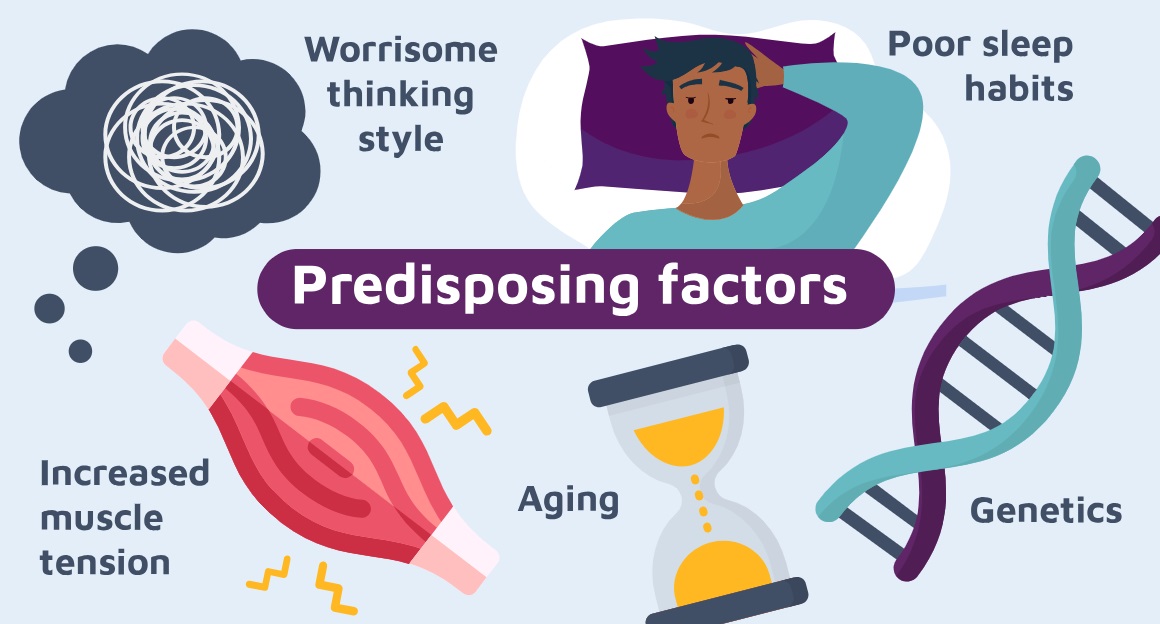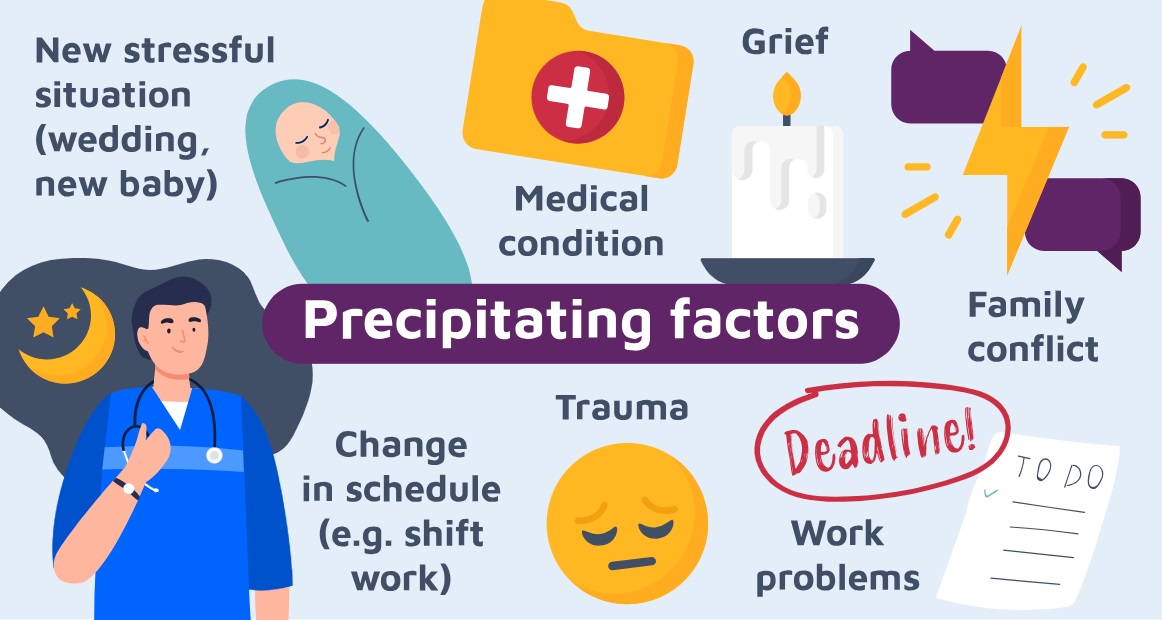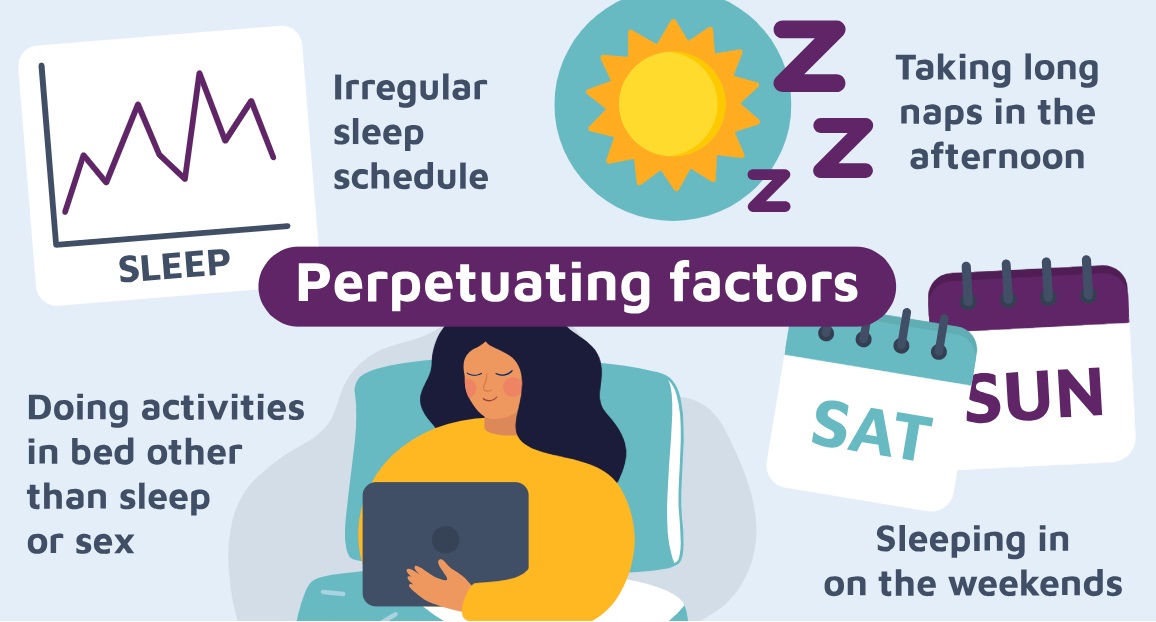Session 2
Welcome back! This is session 2 of the programme.
Last week, we discussed the sleep drive and circadian rhythm, sleep hygiene, and the importance of a wind-down routine. You also received information on how to use your sleep diary. Hopefully you were able to use the sleep diary and you found a wind-down routine that works fits you.
During this session we are going to learn about stimulus control therapy. Next week's session (session 3) will focus on sleep restriction therapy. Don’t be put off by the names, these sleep improvement strategies are not as harsh as they sound. They are established methods that are proven to be effective for improving sleep quality.
To start this session, we will have a small recap of the previous session. After that, we will dive a little deeper on how sleep problems start, progress and continue over time. We will discuss how insomnia develops, how it can be maintained by unhelpful habits, and how we can develop better habits to treat it. As part of this session, you will also gain insight in the rationale behind stimulus control and get specific directions on how to implement it.
SESSION 2: RECAP OF SESSION 1
Below you can find some questions which will test what your remembered of previous session! Give it a try!
Q1: CBT-I, sleep treatment
Q2: Sleep homeostasis
Q3: Circadian rhythm
Q4: Sleep hygiene
Q5: Wind-down
SESSION 2:
The 3P Model – Start and continuation of sleep problems
Different factors can play a role in the initial development and continuation of sleep problems and insomnia. These are Predisposing factors, Precipitating factors and Perpetuating factors, and together are known as the 3P Model.
1. Predisposing factors are things that put people at an increased risk for insomnia. These are factors that make us more prone or “predisposed” to sleep problems, such as:

2. Precipitating factors are things that occur before and bring on or trigger a period of insomnia:

Insomnia that is a result of a stressful situation may go away on its own over time or when the factor causing stress is no longer present, but for some people insomnia continues even after things improve. So, although some factors may have started problems with insomnia, it is likely that the harmful habits you developed to cope with the insomnia are keeping the insomnia going long after the stressful situation has passed.
3. Perpetuating factors are common habits and behaviours which people adopt to cope with insomnia which in effect keep insomnia going over time such as irregular sleep schedule, doing activities in bed other than sleep or sex, sleeping in on the weekends, taking long naps in the afternoon. While those habits and behaviours often are initiated to compensate for sleep loss (and can feel refreshing initially), they often disturb sleep-wake cycles in the long run. For example, if you take naps you will use build up "sleep pressure". By the end of the day, the build-up sleep pressure will not be as high since you already used some part of it by taking naps. This could result in difficulties with falling asleep or staying asleep. Additionally, sleeping in and taking naps can mess-up our internal body clock (24 our rhythm). If we dont adhere to a regular sleep-wake schedule, our bodies have a harder time to know when it is time sleep and to be awake, which results in longer wake times and increased sleepiness during the day.

Even if the precipitating factors (the things which triggered the insomnia in the first place) are kept under control, perpetuating factors can still make the sleep problem worse and prevent recovery. The longer you have had your sleep problem, the more likely it is that perpetuating factors are helping to maintain or worsen your insomnia symptoms.
One of the objectives of the SLEEP programme, therefore, is to help you minimise the influence perpetuating factors have on your sleep.
SESSION 2: Making associations and how it can help us to sleep
All people and even animals make daily associations throughout their whole life. We do this mostly unknowingly to better understand the world and have an easier time to go through life. Our brains constantly seek patterns and connections between different pieces of information, experiences, or stimuli. These associations help us make sense of our environment, predict outcomes, and make decisions (knowingy and unknowingly) more efficiently.
Let's go over some examples so you understand what we mean.
- If we talk about movies and cinema, what food do you think about? Most of you will say popcorn. If you would walk in a ciname, and their would be no snacks and popcorn, that wouldl feel a bit weird right? You would feel like their is something missing maybe?
- We also make associations with events that happened around us. For example, people who were part of a trafic accident will likely have memories pop-up when they pass by the place where the trafic accident took place.
- Associations don't necessarly need to be visual stimili, you can make association with smell, taste, sounds and other stimuli. For example, the smell of freshed baked cookies can remind someone of their grandma who also made home-made cookies.
- Last example, maybe one of the most known one. The experiment of Pavlov. When an assistent fed his dog, he saw that the dog was salivating. But also, when the same assistent passed by, he saw that some dogs started to salivate even though they did not get food. He started to wonder if the technician was a trigger which started the salivating response. To find out, he conducted an expiriment. First, he measured the saliva output when he served the dog food. Second, he started using a sound signal when serving the dog food. He repeated this for several times. Third, he measured the saliva output when only playing the sound and not serving food. The dogs started to salivate in response to the sound alone. Pavlov concluded that if a new stimulus is present when the dog is given food, that stimulus became associated with food and can trigger the same response as the food would (i.e., salivating).
All these examples show that associations can lead to a response which often happens unintentionally. However, associations can be strengtened and responses can be learned. This is something we can use to our advantage and to improve our sleep. With stimulus control techniques, we will try to break the association between feelings of wakefulness and being in bed and create/strengthen the association
between sleepiness and being in bed.
SESSION 2: Stimulus control
With stimilus control, we will retrain your brain to associate sleep with your bedroom and dissociate it with other unhelpful habits. Remember that it takes time to adjust a sleep-wake schedule and to create new habits. Only by sticking to it for a longer time, you will see improvements. You will probably get less sleep than usual in the first week, and that’s normal. This will result in a build-up of sleepiness and help you to fall asleep more quickly after a few nights to a week.
To strengthen the association between sleepiness and being in bed, you only want to be in bed and in your bedroom when you are sleepy. Also you want to avoid lying awake in your bed, because this will brake the association. Below you can find some video which give an overview of the stimilus control techniques which you should keep in mind.
- Go to bed only when sleepy
- Once in bed, if you are unable to sleep within about 20 minutes, get up
- Keep a regular sleep-wake schedule
- No napping during the day
S2: True or False?
Even if you didn't sleep well last night, it’s best to get to bed and wake up at the same scheduled time everyday and not try to make up lost hours of sleep.
True False
Despite our intentions on trying to ‘catch-up on sleep’, this disrupts our circadian rhythm, and our sleep/wake cycle continues to be inconsistent. Sleeping in late will shift our circadian rhythm later, making it more difficult for us to fall asleep that next night. When we sleep in, we are less likely to fall asleep and stay asleep at our planned bedtime for the next night.
It’s best to stay in bed awake as long as possible when you’re trying to get back to sleep.
True False
Staying in bed awake will only weaken the association between the bed and sleepiness. Once in bed, if unable to sleep within about 20 minutes, it's best to get up and only return to bed when feeling sleepy again.
If you take a long nap during the day, it will help you make up for missed sleep.
True False
Despite our intention to catch-up on sleep, taking a long nap during the day will disrupt our circadian rhythm by taking away from our sleep drive and making it more difficult to fall asleep that next night.
S2: Take Home Message
Key Learning Messages
- Your assignment between now and your next therapist-guided session is to continue monitoring your sleep and daytime habits using your sleep diary. Information embedded in the sleep diary will be helpfull to adjust your sleep schedule.
- Implement the stimulus control techniques. Continue re-training your brain to associate sleep with your bedroom and dissociate it with other unhelpful habits.
- Go to bed only when feeling sleepy
- Use the bed only for sleep (and not for activities like watching TV or working)
- Get out of bed if you can't fall asleep after 20 minutes, only return when you feel sleepy
- Wake up at the same time every day
- Avoid napping - Practice the sleep hygiene guidelines and continue with your wind-down routine.
- Prepare for next session. Have a look at your own sleep diaries of previous week and take some time to reflect. What is going well? Do you struggle with something? Are there any challenges? In the following session you will meet online with your therapist. Together, you will review your progress, troubleshoot any difficulties, and work on adapting your sleep schedule.
